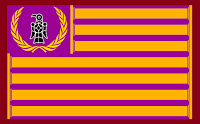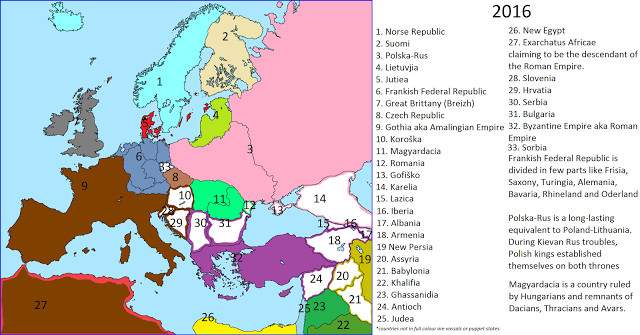Gothia: The Amalingian Empire

The first turning point for Gothia was the battle of Vouillé in 507. The Visigoths fought against the Franks. With the help of Burgundy and the Ostrogoth, the war turned into white peace. Alaric II and his son survived. The Ostrogoth launched a surprise attack through the Alps, which forced the Franks to retreat. After the death of Theodoric, a regency was formed for his grandson. The mother Amalasuntha and the king of the Visigoths Alaric II were part of the regency. Since Alaric II was respected and because Theodoric wished Amalasuntha to be part of the regency, there was little to no opposition leaving both Gothic kingdoms stable. The first step for the unification was done. The Byzantines, only retook Exarchatus Africa, continued their endless wars with the Sassanid Empire and left Italy alone.
The 530s brought many changes. The pope, as well as the Senate, feared Justinian the Great and saw him as threat. Alaric II understood this and tried to use the pope and the Senate in his favour. Alaric tried to adopt Catholicism step by step in order to win the pope and the Latin majority in both kingdoms for himself. He was met with opposition by many Arian Gothic nobles. The Goths lost wars and were suffering internal troubles for some years. Eventually in the 540s they united and the plague was less devastating for the Italian peninsula, as there never was a war with Byzantium to begin with.
Around 550s-570s the unified kingdom of Gothia conquered almost all of Iberia. The new Gothic king would be officially proclaimed Emperor; thus, the Gothia/Amalingian Empire (Amal = his dynasty) was born. In the 590s Gothia participated in a war against Byzantium, which made them a dominant power in the Western Mediterranean. Years later they allied themselves with Breton kingdoms and took on the Franks. Through extensive fights and an alliance with Heraclius (who ruled separated from Constantinople’s authority), the Amalingian Empire made considerable improvements in warfare technology. During the Arab invasions (much smaller than in our timeline), they were able to repel them by the use of Greek fire. From the 680’s onwards to 700’s they took more or less indirect control of North Africa. They promised to protect the Exarchate of Africa from the Arabs.
The Vikings in the North didn’t bother the Amalingian Empire too much. The Gothic marine could handle them with ease, as they continuously improved Greek fire methods on sea. But the power grip on the Frankish/Celtic/Slavic borderlands weakened, resulting in powerful local dukes and a feudal-like system for the borderlands. The rest stayed very centralized, much as Byzantium. Despite their stable situation, their army was never neglected, as it was the duty of almost every subject to be a good soldier. Cavalry was largely used, which helped them to fend off the Hungarians, Pechengs, spontaneous Arab mercenaries or the Mongols from their Empire. Their core land could evolve continuously and technology advanced in many areas. Intern trade was never interrupted and there were continuous international routes from the British Isles to Sahara.
Due to constant wars between Byzantium and New Persia, trade from Asia was very limited. This lead the Gothia in 1200s and 1300s to expand on the seas. Hearing from ‘Vinland’ and retaining many maps from antiquity, they established a trade system similar to the one of OTL Portugal. They competed with Great Brittany, Jutiea and the Norse kingdom for colonies. In the Old World, they were in a permanent Cold War with Byzantium and the Franks, who solidified in the 1500’s, became a strong rival.
Gothic allies were mostly found eastwards, like New Persia or Polska-Rus. The Americas were never totally conquered, comparable to today’s India, but the Goths established Fidusism in there (similar to feudalism). Native countries promised to pay the Goths, while getting protection in return.
There were fewer wars, then in our world but more devastating ones. The worst wars, were World War 1 and World War 2 mostly initiated by the Franks, who lost. The Amalingian Empire expanded steadily. A multipolar Cold War followed, where Byzantium, Polsko-Rus, New Persia and the Amalingian Empire lead loose alliances. In the 2000’s Gothia saw violent political tensions, between Loyalists, Christian Fanatics, Democrats, Fascists, Imperialists, Republicans, Latin/Germanic/Celtic separatists and technocrats. Afterwards, it became clear that the Fascists, Imperialists and technocrats ‘won’ the tensions, which lead the Amalingian Empire to an unknown path. People predict, that the Amalingian Empire will conquer the world and become an interstellar empire in the far future.